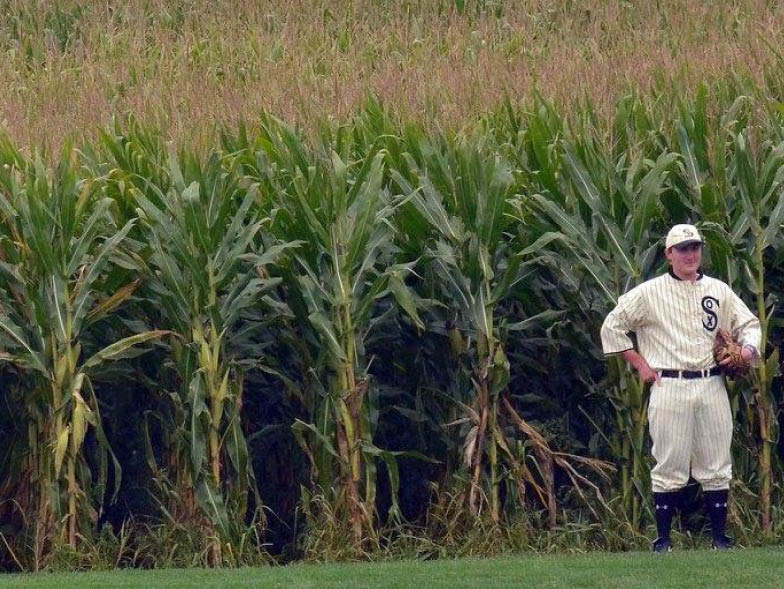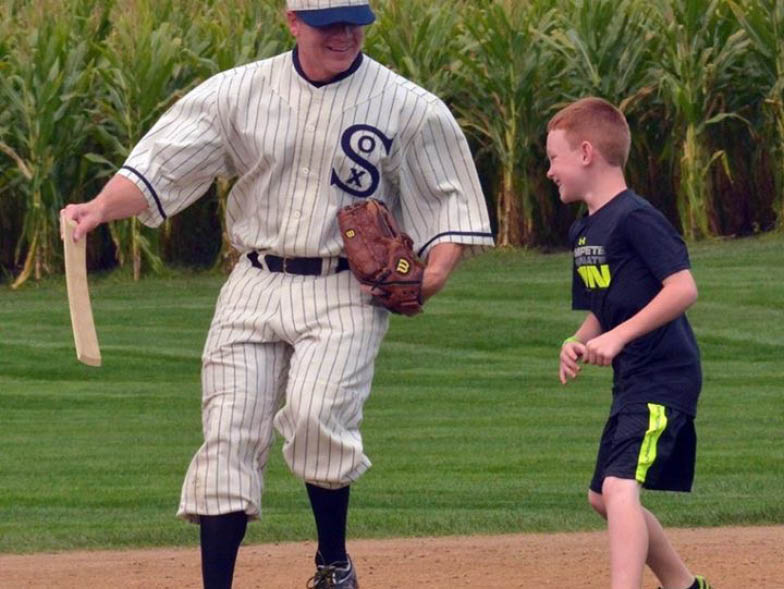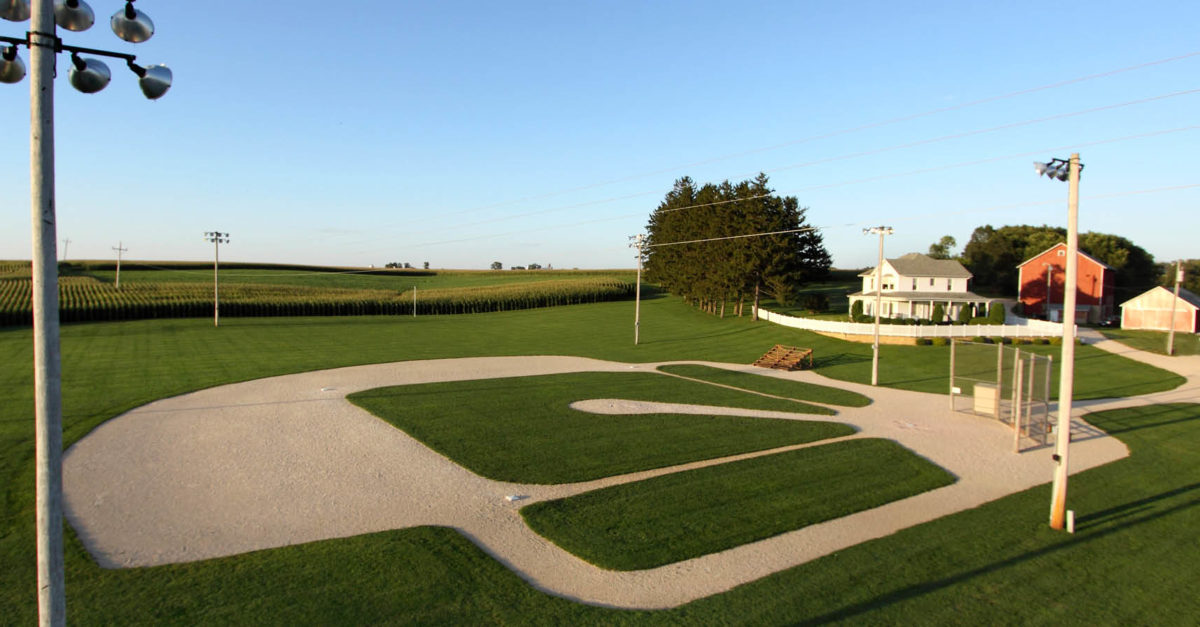Keeping the Dream Alive
“Is this heaven?”
“It’s Iowa.”
“I could have sworn it was heaven.”
This magical conversation between Ray Kinsella and his late father at the end of Field of Dreams, the iconic 1989 baseball movie, is followed by a father-son baseball catch—a reconciliation that’s left legions of men and women choked up, reminiscing about their own family relationships. Today, the movie’s magic lives on at the Field of Dreams Movie Site in Dyersville, Iowa, where the movie was filmed.
Movie buffs and sports fans alike flock to this farming town of 4,100, located approximately ninety minutes north of Davenport and three hours northeast of Des Moines, to experience Field of Dreams firsthand. The attraction is maintained by an ownership group, led by Denise Stillman, that strives to keep alive the legacy of not only the movie but also of Don Lansing, on whose farm the movie was filmed.

The 193-acre farm is well over a century old. The land was first turned into a corn-and-bean farm in 1906 by Lansing’s grandfather, and Lansing eventually bought the farm he grew up on. In 1987, a volunteer from the then Iowa Film Office knocked on his door, asking if she could submit his farm as a possible site for a movie. “Don thought she was crazy,” Stillman notes. “But he OK’d it. When it was selected, it started this whole Cinderella story for him.”
Field of Dreams hit theaters on April 21, 1989, and, according to Stillman, it didn’t take long for the film to have an impact: “The first visitor arrived a few weeks later; he just showed up and sat on the bleachers that were left on Don’s front lawn after the movie. After that, they started coming in droves.
“Plus, these visitors wanted to take a piece of something back with them,” she continues. “They would scoop up gravel from his driveway or take blades of grass from the field. Home plate and the bases were stolen numerous times. So Donnie finally decided to open a souvenir shop.” What followed, Stillman says, was “organic.” Much like the film’s fans drove the need for Lansing’s souvenir shop, their continued devotion to the movie drove the need to preserve the original site. “The baseball field used to be owned by two different families,” she explains. “When the filming was done, the other family, the Ameskamps (whose land encompassed part of the outfield), wanted to plow up the grass and put their crops back in; however, there was a huge outcry about destroying the field, so it was put back in.”
And it grew in popularity. In the 1990s, the “ghost players” from the movie suited up again to play games on Sundays and became a popular attraction; in that same year, the first pro/celebrity game was played. In 2007, the Ameskamps sold their land to Don and Becky Lansing, making the Lansings the sole owners of the baseball field. When they retired, they sold everything to Stillman.

Today, it welcomes over 100,000 visitors a year and is one of Iowa’s top tourist attractions. People visit from all over the country, but most come from within eight hours of the field, from states such as Missouri, Nebraska, Minnesota, Wisconsin, Illinois, and Indiana. However, over the past several years, they’ve also had visitors from nine countries, mostly from Japan and Australia. Couples have gotten married on the field, and people have even asked to spread ashes of their loved ones there. What makes it so special for so many? “It’s the only ball field in America where’s there’s almost always a baseball game going on,” explains Stillman, who grew up a White Sox fan. “Everyone’s welcome—you just bring a glove. It’s America’s greatest pickup game of baseball, played for free, by people from all over the world.”
And, of course, visitors indulge in movie nostalgia. Many, for example, will disappear into the corn and walk back out onto the field in a nod to the ghost players in the movie. The cornfield itself is something of an agricultural feat, Stillman explains: “The really special thing about the crops is that all the rows of corn are planted facing home plate. So when you’re standing at home plate, you have a beautiful outfield fence of perfect corn rows to look into. This also makes it easier to find baseballs, as well as to find your way to the field if you get lost in the corn.”
Other visitors opt to sit in the bleachers—which are the originals from the movie, including the top bleacher where Kevin Costner’s character carved “Ray loves Annie”—and take photos of the field. Others just sit under the trees taking in the beauty of a pristine, quiet ballpark. In 2016, this nostalgic experience expanded to off the field: the Lansings’ farmhouse, which had been used in the movie, was transformed to look like the Kinsellas still lived there. “We’ve had lots of people come through the house, and they absolutely love being part of a place that’s truly historic from an American icon perspective,” Stillman says. “It brings people back to their favorite parts of the movie.”
Every September, the site also hosts Team of Dreams, a popular event for which visitors can purchase tickets to watch former major league players and celebrities play a charity game. Hall of Famers like Reggie Jackson, Ozzie Smith, and Wade Boggs play every year, and others like Ivan Rodriguez, Andre Dawson, Johnny Bench, Robin Yount, and Steve Carlton have played in the past. (“It’s something to see a Hall of Fame player get choked up by playing
on the Field of Dreams,” Stillman notes.) Team of Dreams also includes a celebrity breakfast in neighboring Dubuque and Q and A sessions with the players.

In addition, during Father’s Day weekend in 2014, Costner came back to mark the movie’s twenty-fifth anniversary, as did Dwier Brown and Timothy Busfield (who play Ray’s father and brother-in-law, respectively, in the movie), and they all played ball with former pros and other celebrities, like Bob Costas.
Another exciting project is also on-deck for the site. “We’re building a beautiful baseball and softball campus called All-Star Ballpark Heaven on the northwest side of the property, totally separate from the Field of Dreams,” Stillman reveals. “It will house twenty-four smaller baseball fields that are replicas of ballparks long gone, like Ebbets Field and Forbes Field. These will help younger people experience ballparks they didn’t get a chance to see in person, learn about baseball legends like Shoeless Joe Jackson and Joe DiMaggio, grow their love of the game, and teach them life skills during their week-long tournaments and training with us.”
These are all part of the experience that Stillman hopes to provide for the fans of the movie for years to come. “The most special moments I have are when people learn I manage the property,” she confides. “They lean in and hug me and sob. They just need to thank someone for preserving the field. Those are the people coming here to reconcile with someone they weren’t able to do so in this life, or they want to remember the bonds that baseball meant for them and their loved ones, usually a mom or dad. It’s a very interesting role to play in America’s history by preserving this place, because it means a lot of different things to a lot of different people. It’s an honor and a privilege to maintain it.”
For Stillman, her continuing Field of Dreams Movie Site work has had a bigger purpose—and, much like the movie itself, it goes beyond the baseball diamond. “It’s taught me a lot of lessons about life,” she shares. “It’s taught me about the impact the game of baseball has on our culture and society, and, most important, the impact this movie has had on America and our ability to relate to each other as family.”
For more info, visit fieldofdreamsmoviesite.com.






















